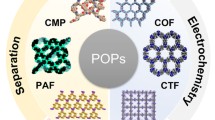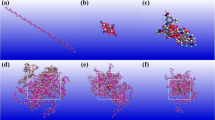Abstract
After the surface silylation with 3-methacryloxypropyltrimethoxysilane, silica nanoparticles were further modified by 9,10-dihydro-9-oxa-10-phosphaphenanthrene-10-oxide (DOPO). The immobilization of DOPO on silica nanoparticles was confirmed by Fourier transform infrared spectroscopy, UV–visible spectroscopy, magic angle spinning nuclear magnetic resonance, and thermogravimetric analysis. By incorporating the DOPO-immobilized silica nanoparticles (5 wt%) into polypropylene matrix, the thermal oxidative stability exhibited an improvement of 62 °C for the half weight loss temperature, while that was only 26 °C increment with incorporation of virgin silica nanoparticles (5 wt%). Apparent activation energies of the polymer nanocomposites were estimated via Flynn–Wall–Ozawa method. It was found that the incorporation of DOPO-immobilized silica nanoparticles improved activation energies of the degradation reaction. Based on the results, it was speculated that DOPO-immobilized silica nanoparticles could inhibit the degradation of polypropylene and catalyze the formation of carbonaceous char on the surface. Thus, thermal stability was significantly improved.










Similar content being viewed by others
References
Zou H, Wu SS, Shen J (2008) Polymer/silica nanocomposites: preparation, characterization, properties, and applications. Chem Rev 108:3893–3957
Sanchez C, Julian B, Belleville P, Popall M (2005) Applications of hybrid organic–inorganic nanocomposites. J Mater Chem 15:3559–3592
Slowing II, Vivero-Escoto JL, Trewyn BG, Lin VSY (2010) Mesoporous silica nanoparticles: structural design and applications. J Mater Chem 20:7924–7937
Pajonk GM (2003) Some applications of silica aerogels. Colloid Polym Sci 281:637–651
Ciprari D, Jacob K, Tannenbaum R (2006) Characterization of polymer nanocomposite interphase and its impact on mechanical properties. Macromolecules 39:6565–6573
Rong MZ, Zhang MQ, Zheng YX, Zeng HM, Walter R, Friedrich K (2001) Structure-property relationships of irradiation grafted nano-inorganic particle filled polypropylene composites. Polymer 42:167–183
Chinthamanipeta PS, Kobukata S, Nakata H, Shipp DA (2008) Synthesis of poly(methyl methacrylate)-silica nanocomposites using methacrylate-functionalized silica nanoparticles and RAFT polymerization. Polymer 49:5636–5642
Yao XY, Tian XY, Xie DH, Zhang X, Zheng K, Xu J, Zhang GZ, Cui P (2009) Interface structure of poly(ethylene terephthalate)/silica nanocomposites. Polymer 50:1251–1256
Asuka K, Liu BP, Terano M, Nitta KH (2006) Homogeneously dispersed poly(propylene)/SiO2 nanocomposites with unprecedented transparency. Macromol Rapid Commun 27:910–913
Bula K, Jesionowski T, Krysztafkiewicz A, Janik J (2007) The effect of filler surface modification and processing conditions on distribution behaviour of silica nanofillers in polyesters. Colloid Polym Sci 285:1267–1273
Shukoor MI, Natalio F, Therese HA, Tahir MN, Ksenofontov V, Panthofer M, Eberhardt M, Theato P, Schroder HC, Muller WEG, Tremel W (2008) Fabrication of a silica coating on magnetic gamma-Fe2O3 nanoparticles by an immobilized enzyme. Chem Mater 20:3567–3573
Qhobosheane M, Santra S, Zhang P, Tan WH (2001) Biochemically functionalized silica nanoparticles. Analyst 126:1274–1278
Jesionowski T, Krysztafkiewicz A (2001) Influence of silane coupling agents on surface properties of precipitated silicas. Appl Surf Sci 172:18–32
Jal PK, Patel S, Mishra B (2004) Chemical modification of silica surface by immobilization of functional groups for extractive concentration of metal ions. Talanta 62:1005–1028
Mahmoud ME, Soliman EM (1997) Study of the selective extraction of iron (III) by silica-immobilized 5-formyl-3-arylazo-salicylic acid derivatives. Talanta 44:1063–1071
Rioux RM, Song H, Hoefelmeyer JD, Yang P, Somorjai GA (2005) High-surface-area catalyst design: synthesis, characterization, and reaction studies of platinum nanoparticles in mesoporous SBA-15 silica. J Phys Chem B 109:2192–2202
Phan NTS, Brown DH, Styring P (2004) A facile method for catalyst immobilisation on silica: nickel-catalysed Kumada reactions in mini-continuous flow and batch reactors. Green Chem 6:526–532
Behr M, Rosentritt M, Hagenbuch K, Faltermeier A, Handel G (2009) Flexural strength of experimentally filled resins made of electron beam irradiated silica fillers. J Mech Behav Biomed Mater 2:61–64
Alongi J, Ciobanu M, Malucelli G (2011) Novel flame retardant finishing systems for cotton fabrics based on phosphorus-containing compounds and silica derived from sol-gel processes. Carbohydr Polym 85:599–608
Brancatelli G, Colleoni C, Massafra MR, Rosace G (2011) Effect of hybrid phosphorus-doped silica thin films produced by sol-gel method on the thermal behavior of cotton fabrics. Polym Degrad Stab 96:483–490
Gao XW, Meng XF, Wang HT, Wen B, Ding YF, Zhang SM, Yang MS (2008) Antioxidant behaviour of a nanosilica-immobilized antioxidant in polypropylene. Polym Degrad Stab 93:1467–1471
Gao XW, Hu GJ, Qian ZZ, Ding YF, Zhang SM, Wang DJ, Yang MS (2007) Immobilization of antioxidant on nanosilica and the antioxidative behavior in low density polyethylene. Polymer 48:7309–7315
Chen J, Yang MS, Zhang SM (2011) Immobilization of antioxidant on nanosilica and the aging resistance behavior in polypropylene. Compos Part A-Appl S 42:471–477
Levchik SV, Weil ED (2006) A review of recent progress in phosphorus-based flame retardants. J Fire Sci 24:345–364
Liu YL, Wu CS, Hsu KY, Chang TC (2002) Flame-retardant epoxy resins from o-cresol novolac epoxy cured with a phosphorus-containing aralkyl novolac. J Polym Sci Part A Polym Chem 40:2329–2339
Semenzin D, EtemadMoghadam G, Albouy D, Diallo O, Koenig M (1997) Dual radical/polar Pudovik reaction: application field of new activation methods. J Org Chem 62:2414–2422
Perret B, Schartel B, Stoess K, Ciesielski M, Diederichs J, Doering M, Kraemer J, Altstaedt V (2011) Novel DOPO-based flame retardants in high-performance carbon fibre epoxy composites for aviation. Eur Polym J 47:1081–1089
Wang X, Hu Y, Song L, Yang H, Xing W, Lu H (2011) Synthesis and characterization of a DOPO-substitued organophosphorus oligomer and its application in flame retardant epoxy resins. Prog Org Coat 71:72–82
Zhang W, Li X, Guo X, Yang R (2010) Mechanical and thermal properties and flame retardancy of phosphorus-containing polyhedral oligomeric silsesquioxane (DOPO-POSS)/polycarbonate composites. Polym Degrad Stab 95:2541–2546
Zang L, Wagner S, Ciesielski M, Mueller P, Doering M (2011) Novel star-shaped and hyperbranched phosphorus-containing flame retardants in epoxy resins. Polym Adv Technol 22:1182–1191
Ma BY, Lii JH, Schaefer HF, Allinger NL (1996) Systematic comparison of experimental, quantum mechanical, and molecular mechanical bond lengths for organic molecules. J Phys Chem 100:8763–8769
Bauer F, Ernst H, Decker U, Findeisen M, Glasel HJ, Langguth H, Hartmann E, Mehnert R, Peuker C (2000) Preparation of scratch and abrasion resistant polymeric nanocomposites by monomer grafting onto nanoparticles, 1-FTIR and multi-nuclear NMR spectroscopy to the characterization of methacryl grafting. Macromol Chem Phys 201:2654–2659
Derouet D, Forgeard S, Brosse JC, Emery J, Buzare JY (1998) Application of solid-state NMR (C-13 and Si-29 CP/MAS NMR) spectroscopy to the characterization of alkenyltrialkoxysilane and trialkoxysilyl-terminated polyisoprene grafting onto silica microparticles. J Polym Sci Part A Polym Chem 36:437–453
Zhong HF, Wu D, Wei P, Jiang PK, Li Q, Hao JW (2007) Synthesis, characteristic of a novel additive-type flame retardant containing silicon and its application in PC/ABS alloy. J Mater Sci 42:10106–10112
Liu CH, Pan CY (2007) Grafting polystyrene onto silica nanoparticles via RAFT polymerization. Polymer 48:3679–3685
Jana SC, Jain S (2001) Dispersion of nanofillers in high performance polymers using reactive solvents as processing aids. Polymer 42:6897–6905
Wang Y, Wu X, Yang W, Zhai Y, Xie B, Yang M (2011) Aggregate of nanoparticles: rheological and mechanical properties. Nanoscal Res Lett 6:114
Zanetti M, Camino G, Reichert P, Mulhaupt R (2001) Thermal behaviour of poly(propylene) layered silicate nanocomposites. Macromol Rapid Commun 22:176–180
Hinsken H, Moss S, Pauquet JR, Zweifel H (1991) Degradation of polyolefins during melt processing. Polym Degrad Stab 34:279–293
Wang X, Hu Y, Song L, Xing WY, Lu HD, Lv P, Jie GX (2010) Flame retardancy and thermal degradation mechanism of epoxy resin composites based on a DOPO substituted organophosphorus oligomer. Polymer 51:2435–2445
Qian LJ, Zhi JG, Tong B, Shi JB, Yang F, Dong YP (2009) Synthesis and characterization of main-chain liquid crystalline copolyesters containing phosphaphenanthrene side-groups. Polymer 50:4813–4820
Palza H, Vergara R, Zapata P (2010) Improving the thermal behavior of poly(propylene) by addition of spherical silica nanoparticles. Macromol Mater Eng 295:899–905
Gianelli W, Ferrara G, Camino G, Pellegatti G, Rosenthal J, Trombini RC (2005) Effect of matrix features on polypropylene layered silicate nanocomposites. Polymer 46:7037–7046
Liu YL, Wei WL, Hsu KY, Ho WH (2004) Thermal stability of epoxy-silica hybrid materials by thermogravimetric analysis. Thermochim Acta 412:139–147
Menczel JD, Prime RB (2009) Thermal analysis of polymers—fundamentals and applications. Wiley, New Jersey
Chigwada G, Kandare E, Wang DY, Majoni S, Mlambo D, Wilkie CA, Hossenlopp JM (2008) Therma stabiliy and degradation kinetics of polystyrene/organically-modified montmorillonite nanocomposites. J Nanosci Nanotech 8:1927–1936
Ozawa T (1965) A new method of analyzing thermogravimetric data. B Chem Soc Jpn 38:1881–1886
Flynn JH, Wall LA (1966) A quick direct method for determination of activation energy from thermogravimetric data. J Polym Sci B Polym Lett 4:323–328
Flynn JH (1983) The isoconversional method for determination of energy of activation at constant heating rates—corrections for the Doyle approximation. J Therm Anal 27:95–102
Benson SW, Nangia PS (1979) Some unresolved problems in oxidation and combustion. Acc Chem Res 12:223–228
Acknowledgments
The authors thank Dr. Junfeng Xiang and Ms. Aijiao Guan for the helpful discussion about the NMR experiment. This work was financially supported by the National Natural Science Foundation of China (grant no. 21074142 and 51133009) and the National High Technology Research and Development Program of China (863 Program; no. 2009AA033601).
Author information
Authors and Affiliations
Corresponding authors
Rights and permissions
About this article
Cite this article
Dong, Q., Ding, Y., Wen, B. et al. Improvement of thermal stability of polypropylene using DOPO-immobilized silica nanoparticles. Colloid Polym Sci 290, 1371–1380 (2012). https://doi.org/10.1007/s00396-012-2631-0
Received:
Revised:
Accepted:
Published:
Issue Date:
DOI: https://doi.org/10.1007/s00396-012-2631-0




